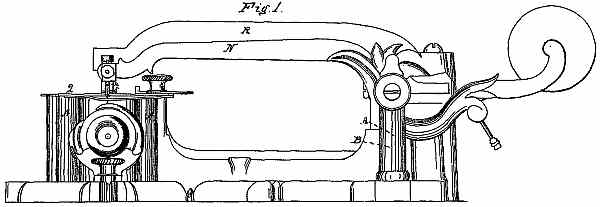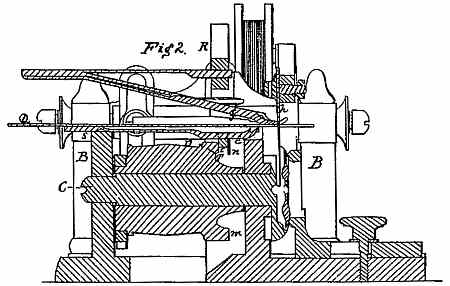
To all whom it may concern:
Be it known that I, ALLEN B. WILSON, of Watertown, in the county of Litchfield and
State of Connecticut,
have invented certain new and useful Improvements in Sewing-Machines;
and I do hereby declare that the following is a full clear, and exact
description of the same, reference being had to the accompanying
drawings, forming part of this specification, in which—
Figure 1 is a side elevation of the machine; and Fig. 2 is
a transverse
vertical section of the same, taken through the parts which form the
stitches, and represents the peculiar arrangement for feeding the cloth
along, in which said improvements consist.
To enable those skilled in the art to make and use my
invention, I
will describe its construction and operation.

The working parts of the machine are all attached to or
carried by a
suitable framework, A A B B, which is secured firmly to a table or
bench. The mandrel C, resembling in a certain degree the mandrel of a
lathe, is fitted in suitable bearings in the framework A A B B, and is
suitably turned or provided with a pulley, D, to receive the rotary
motion, through a driving-band, from a driving-wheel moved by a
treadle under the table, or by any suitable means.
The operative parts of this machine and its construction
are
substantially the same as those described in Letters Patent of the
United States, bearing date the 15th day of June, A. D. 1852, granted
to Nathaniel Wheeler, A. B. Wilson, Alamson Warren, and S. P.
Woodruff, of Watertown aforesaid.
The material to be sewed is laid upon a plate, Q, which is
secured to
the standards A A, and forms a small table. It is held down by a small
pressing-spring, which is attached to the end of an arm, R, which is
secured to the back of the frame-work, and extends over the top of the
machine. In the front end of the pressing-spring f there is a slot, g,
cut to allow the needle to pass through. An opening corresponding to
the slot g, is cut through
the plate Q for the same purpose.

The arrangement for feeding the cloth along is shown in
Fig. 2,
and
consists of a feed-bar, S. It is a straight flat bar with a slot
extending nearly its whole length and with a projection, i, downward.
Under the slot is secured a spring-bar, k, which is furnished with
pointed teeth or notches at the end. The bar S slides in suitable
bearings in the frame B B, immediately below the plate Q. The teeth or
notches of the spring-bar k
are immediately under a small opening in
plate Q, but do not arise through this opening until pressure is
applied to the spring-bar k
by the revolution of the cam T upon the
mandrel, which cam is nearly cylindrical and concentric to the
mandrel; but at one point in its periphery there is a prominence. This
prominence extends also to the front. By the revolution of the mandrel
the prominence of the cam is made to act on the under side of the
spring-bar k and force up its
teeth or notches in contact with the
cloth at the same time that its front part acts on the projection i and
moves the feed-bar longitudinally forward toward the plane of the
needle's motion, carrying the cloth with it. The movement of the
feed-bar while its points or notches are above the surface of the
plate Q and in contact with the cloth causes the cloth to move forward
the proper distance for a stitch at each ascent of the needle, the bar
being returned by the pressure of the spring n; attached to the
frame-work, against the projection i
after the prominence m on the
cam
has passed, the notches or teeth being freed from the cloth as soon as
the prominence of the cam is clear of the spring-bar, by the force of
the spring portion of said bar.
What I claim as my invention, and desire to have secured
to me by
Letters Patent, is—
The device above described in a sewing-machine for feeding
the Cloth
along, consisting of a bar furnished with points or notches; having a
vertical or up-and-down motion for fastening the cloth upon and,
releasing it from said bar by striking it against a plate or spring,
and a lateral motion or motion forward and back for feeding the
cloth
along after each stitch, substantially as above set forth.
ALLEN B. WILSON.
Witnesses:
HENRY
BRONSON,
FREDK.
HURD.
